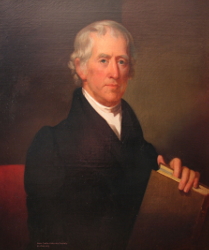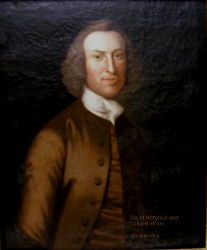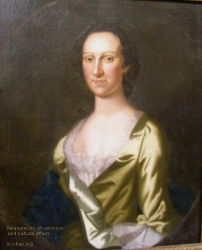Kensey Johns Sr. (1759-1848)
 Click on image to enlarge or for higher resolution |
Title/Occupation | Chief Justice DE Supreme Court (1799-1830), Chancellor (1830-1832) |
|---|---|---|
| Address | 2 E. 4th St., 2 E. 3rd. St. | |
| Artist | Jacob Eicholtz/James Reid Lambdin | |
| Date painted | c1825 | |
| Credit | New Castle Historical Society/State Portrait Commission * | |
| Married | Ann Van Dyke (1784) | |
| Parents | Kensey Johns & Susannah Galloway | |
| Children | Fidelia (1785-1871) Ann (1787-1874) Susannah Stewart (1789-1862) Kensey Jr (1791-1857) John Johns (1796-1876) Van Dyke (1798-1801) Henrietta (c1800- 1837, m c1820, 1823) disowned* Henry Van Dyke (1803 -1859) | |
Wikipedia | ||
The man known in Delaware as Kensey Johns Sr. is the third in his family with that name. Watercolor images of Kensey & Susannah Johns II Kensey Johns Sr. was wealthy. His assets were the sixth highest of 160 individuals in the 1826 tax lists for New Castle, after Nicholas van Dyke Jr., James Booth Jr. and George Read Jr. Like Thomas Jefferson, he was a gentleman architect, and designed his own home at the corner of E 3rd. and Delaware. His drawings exist showing the several stages of the development of his plans. He owned considerable property in the county, including in the path of the proposed C&D canal, of which he was a director According to the biography of John Johns, "The Virgina Bishop", Kensey disowned his daughter Henrietta, supposedly for marrying an Irish plantation manager in Virginia. I wonder if he was also alienated from two of his three sons. John reportedly last came back to New Castle from College in 1816, both Rev. John and Rev. Henry Van Dyke Johns led parishes in Maryland and Virginia but never in Delaware, and Bishop John did not let others know of his distinguished and wealthy father. The description of Kensey Johns Sr. in Latrobe's journal was most unflattering.
[Johns] is a judge. A Man of keen intelligence, a political Cameleon, in pecuniary
honesty a bankrupt, but very rich, and from nothing possessed like all other Lawyers
of immense tracts of Land in the state. This judge was Treasurer of a Lottery scheme
for the erection of piers to protect the harbor. It so happened that the prizes were not
paid. After much hard squeezing and difficulty, he consented to regorge.
This description was probably colored by joint land dealings. Latrobe was in financial difficulty, but perhaps at Johns suggestion or urging, the two purchased a farm near modern Glasgow where the planned canal and feeder would meet. But the canal construction was abandoned.
| ||
Jim Meek
nc-chap.org 2014, 2015
nc-chap.org 2014, 2015

